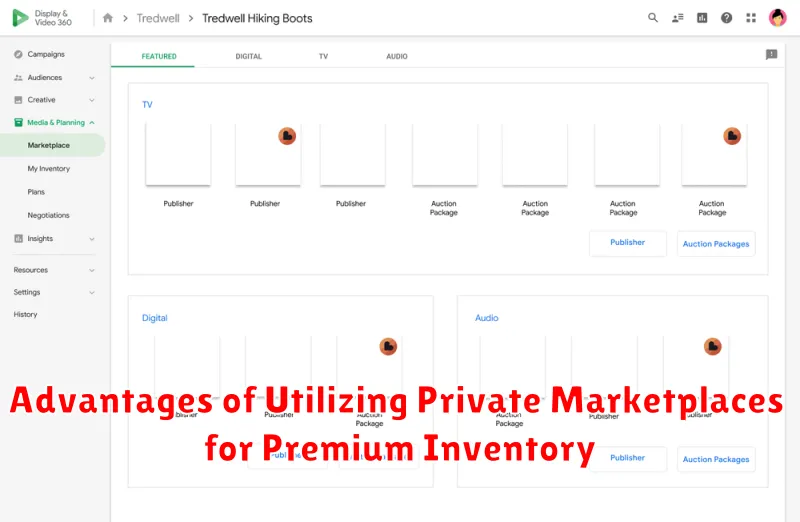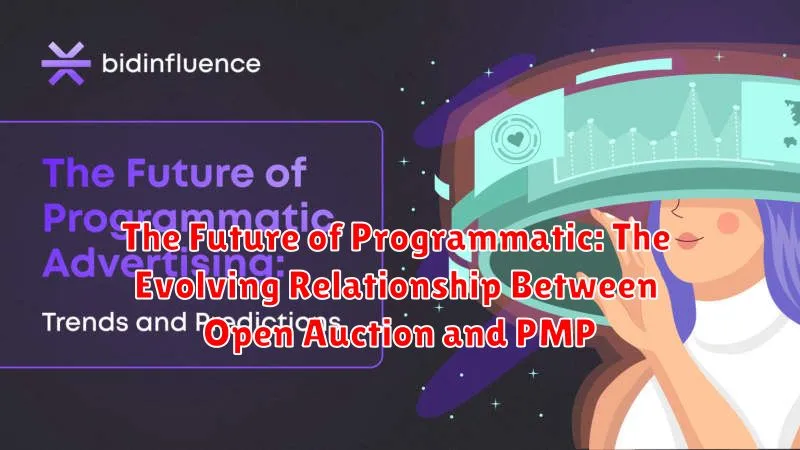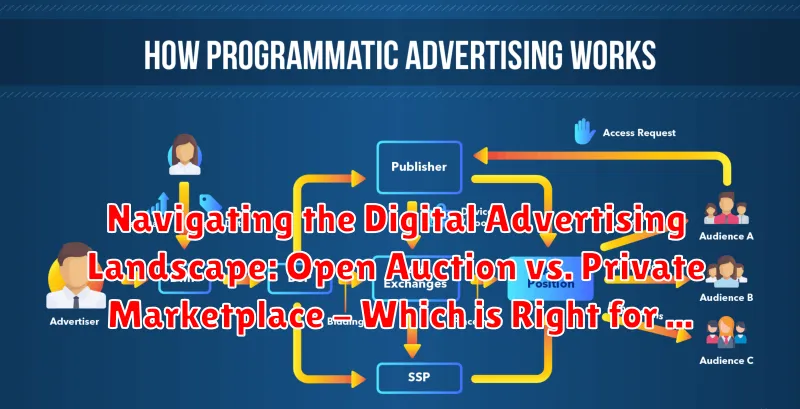The world of digital advertising is constantly evolving, presenting marketers with a myriad of choices for reaching their target audiences. Two prominent methods are the Open Auction and the Private Marketplace (PMP). Understanding the nuances of each is crucial for maximizing your advertising ROI and achieving your campaign goals. This article will delve into the intricacies of both Open Auction and Private Marketplace models, providing a comprehensive guide to help you navigate the digital advertising landscape effectively and choose the optimal strategy for your needs.
Selecting the right digital advertising approach requires careful consideration of your budget, target audience, and desired level of control. While the Open Auction offers broad reach and competitive pricing, the Private Marketplace provides access to premium inventory and enhanced targeting capabilities. By exploring the benefits and drawbacks of each, this article equips you with the knowledge to make informed decisions and leverage the power of programmatic advertising through either the Open Auction or a strategically chosen Private Marketplace deal.
What is the Open Auction in Programmatic Advertising?
The open auction, also known as open exchange or real-time bidding (RTB), is a public marketplace where advertisers can bid on ad impressions in real-time. This programmatic advertising method allows for a broad reach, enabling advertisers to access a vast pool of available inventory across numerous websites and apps.
In an open auction, publishers make their ad inventory available to any advertiser willing to bid. The auction takes place in milliseconds, with the highest bidder winning the impression and their ad being displayed to the user.
Key characteristics of the open auction include:
- Accessibility: Open to all advertisers and publishers.
- Transparency: Relatively transparent regarding available inventory and pricing, though specific website details may not always be revealed upfront.
- Scalability: Offers the greatest scale and reach compared to other programmatic buying methods.
Understanding the Dynamics of the Open Auction Process
The open auction, also known as Real-Time Bidding (RTB), functions as a vast, publicly accessible marketplace where advertisers compete for ad impressions. Understanding its dynamics is crucial for successful programmatic advertising.
Here’s a breakdown of the process:
- User Visit: A user visits a website containing ad space.
- Ad Request: The publisher’s ad server sends an ad request to the ad exchange, including user data and information about the available ad space.
- Auction Initiation: The ad exchange broadcasts the ad request to participating Demand-Side Platforms (DSPs).
- Bid Submission: DSPs, representing advertisers, analyze the user data and bid on the impression based on predefined targeting parameters and budget.
- Winner Determination: The ad exchange selects the highest bid.
- Ad Serving: The winning ad is served to the user in real-time.
This entire process occurs in milliseconds, enabling a dynamic and efficient allocation of ad inventory. The price is determined by real-time competition, with the highest bidder securing the impression.
What is a Private Marketplace (PMP) and How Does it Work?
A Private Marketplace (PMP), also known as a closed auction or a programmatic direct deal, is an invite-only digital advertising marketplace where publishers offer their ad inventory to a select group of advertisers. Unlike the open auction, which is available to all advertisers, a PMP provides a more controlled and premium environment.
Here’s how it typically works:
- Publisher Invitation: Publishers identify and invite specific advertisers they want to participate in their PMP.
- Deal ID Negotiation: Publishers and advertisers negotiate terms, including pricing (often CPM), ad formats, and targeting criteria. A unique Deal ID is created for this agreement.
- Inventory Offering: The publisher makes specific ad inventory available to the invited advertisers through the PMP, using the agreed-upon Deal ID.
- Advertiser Bidding: Invited advertisers can bid on the available inventory using their Demand-Side Platforms (DSPs), utilizing the Deal ID to target the specified inventory.
- Ad Serving: If an advertiser’s bid wins, the ad is served to the targeted audience on the publisher’s website or app.
The Key Differences Between Open Auction and Private Marketplace
The open auction and private marketplace (PMP) represent distinct approaches to programmatic advertising. Understanding their key differences is crucial for effective campaign strategy.
Access and Inventory: Open auctions are, as the name implies, open to virtually any advertiser. PMPs, on the other hand, offer exclusive access to premium inventory from specific publishers, often by invitation only.
Pricing: Open auctions rely on real-time bidding, where prices fluctuate based on supply and demand. PMPs often involve pre-negotiated rates or floor prices, providing greater cost predictability.
Transparency and Control: PMPs offer enhanced transparency, allowing advertisers to know exactly where their ads will appear. Open auctions provide less control over placement, potentially leading to ads appearing on less desirable websites.
Ad Quality and Brand Safety: PMPs typically guarantee higher ad quality and greater brand safety due to the premium nature of the inventory and the direct relationship with publishers.
Benefits of Using the Open Auction for Advertising Campaigns
The open auction, a cornerstone of programmatic advertising, provides several compelling benefits for advertisers. Its broad reach allows access to a vast pool of publishers and ad inventory, increasing the potential to reach a diverse audience.
Here are some key advantages:
- Scalability: Easily scale campaigns up or down based on performance and budget.
- Cost-Effectiveness: Competitive bidding often results in lower CPMs (Cost Per Mille) compared to private marketplaces.
- Wide Reach: Access a diverse range of websites and apps, potentially reaching niche audiences.
- Flexibility: Adapt campaigns quickly based on real-time data and performance insights.
The open auction is particularly well-suited for campaigns focused on broad reach, brand awareness, and efficient budget utilization. Advertisers can test different targeting strategies and creative executions with relative ease.
Advantages of Utilizing Private Marketplaces for Premium Inventory

Private Marketplaces (PMPs) offer distinct advantages for advertisers seeking access to premium inventory. Unlike the open auction, PMPs provide a controlled environment that fosters higher quality placements and greater transparency.
Here are some key benefits:
- Premium Inventory Access: Gain exclusive access to high-value ad placements on reputable publishers’ websites, often unavailable in the open auction.
- Brand Safety: Mitigate the risk of ad misplacement by ensuring ads appear on pre-approved websites aligned with brand values.
- Targeted Reach: Leverage advanced targeting options, including first-party data, to reach specific audience segments with increased accuracy.
- Greater Control: Exercise greater control over inventory selection, pricing, and ad placement, leading to more predictable outcomes.
- Direct Relationships: Cultivate direct relationships with publishers, fostering collaboration and potentially unlocking unique opportunities.
By leveraging PMPs, advertisers can enhance their brand image, improve campaign performance, and achieve more predictable results compared to the often unpredictable nature of the open auction environment.
Factors to Consider When Choosing Between Open Auction and PMP
Selecting the right programmatic advertising method requires a careful evaluation of your campaign goals and resources. Several critical factors influence the decision between the Open Auction and a Private Marketplace (PMP).
Consider the following:
- Budget: Open auctions are typically more cost-effective for broader reach, while PMPs often require a higher investment for premium inventory.
- Target Audience: PMPs allow for more precise targeting and access to specific demographics not readily available in the open auction.
- Brand Safety: PMPs offer enhanced brand safety controls and a curated inventory environment.
- Inventory Quality: Determine the importance of premium, guaranteed inventory versus the broad, often variable quality inventory of the open auction.
- Reporting Needs: Asses what level of transparency and reporting is required. PMPs generally offer more detailed reporting.
By thoroughly examining these factors, you can make an informed decision that aligns with your advertising objectives and maximizes your return on investment.
Open Auction vs. Private Marketplace: A Cost-Benefit Analysis
Evaluating the cost-effectiveness of open auctions versus private marketplaces (PMPs) requires a nuanced understanding of your advertising goals and budget constraints. Open auctions generally offer lower costs per impression due to the competitive bidding environment and wider pool of available inventory.
However, this lower cost can be offset by lower quality inventory and increased risk of ad fraud, potentially leading to a diminished return on investment (ROI). PMPs, while typically involving higher CPMs, provide access to premium inventory and greater control over ad placement, resulting in improved brand safety and potentially higher engagement rates.
A thorough cost-benefit analysis should consider not only the CPMs but also factors such as:
- Target audience reach and relevance: Does the inventory align with your ideal customer profile?
- Ad fraud risk and brand safety concerns: Are you adequately protected against malicious actors?
- Potential for increased conversion rates: Will the higher quality inventory lead to more sales or leads?
- Operational costs: Resources required to manage campaigns on each platform
Ultimately, the optimal choice depends on your specific needs and priorities. Carefully weigh the potential benefits and costs of each approach to make an informed decision that aligns with your overall marketing strategy.
Best Practices for Optimizing Campaigns in Both Open Auction and PMP
Optimizing campaigns in both the Open Auction and Private Marketplace (PMP) environments requires a nuanced approach. While both offer programmatic advertising opportunities, their dynamics necessitate distinct strategies.
For Open Auction:
- Granular Targeting: Employ precise targeting parameters (demographics, interests, contextual) to minimize wasted impressions.
- Bid Management: Continuously monitor and adjust bids based on performance data. Implement bid shading techniques to optimize cost efficiency.
- Creative Optimization: A/B test different ad creatives to identify high-performing variations.
- Real-Time Monitoring: Closely track key performance indicators (KPIs) and make adjustments in real-time.
For Private Marketplace (PMP):
- Deal ID Management: Ensure accurate implementation and tracking of Deal IDs to access agreed-upon inventory.
- Performance Analysis: Monitor the performance of each PMP deal and identify areas for improvement.
- Relationship Management: Maintain open communication with publishers to optimize deal terms and performance.
- Creative Alignment: Ensure ad creatives are aligned with the premium content and audience of the PMP publisher.
The Future of Programmatic: The Evolving Relationship Between Open Auction and PMP

The programmatic landscape is in constant flux, and the relationship between the Open Auction and Private Marketplaces (PMPs) is evolving. We are seeing a trend towards hybrid models that leverage the strengths of both approaches.
One key area of evolution is the increasing sophistication of data targeting. Advertisers are demanding more granular control over audience selection and are using first-party data to enhance their programmatic buys across both Open Auctions and PMPs. This data-driven approach allows for more personalized and effective advertising, regardless of the buying method.
Furthermore, there’s growing emphasis on transparency and brand safety. Publishers are under pressure to provide greater visibility into inventory sources, and advertisers are demanding safeguards to protect their brands from appearing alongside inappropriate content. This focus is likely to lead to stricter quality controls and more robust verification mechanisms within both Open Auctions and PMPs.

